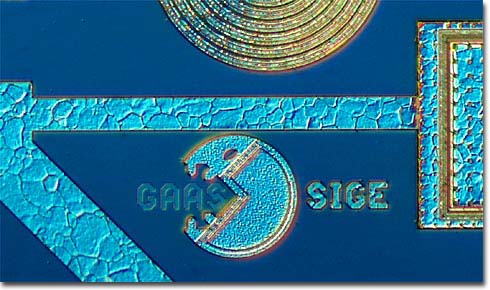Pac-Man
|
We spotted this silicon Pac-Man gobbling the initials GAAS (gallium arsenide) on a TEMIC Semiconductors silicon-germanium radio frequency integrated circuit. This chip is the first Digital Enhanced Cordless Telecommunications (DECT) device produced with silicon-germanium technology, replacing the usual gallium arsenide power amplifier devices normally used in DECT applications. Similar devices made using gallium arsenide are expensive and normally require a negative auxiliary voltage. We assume the Pac-Man silicon icon was planted on the chip as a symbolic gesture to the fact that devices made with silicon-germanium are poised to "eat up" the gallium arsenide-based competition. Pac-Man was originally designed by Toru Iwantani and programmed by Hideyuki Mokajima and his associates. The name Pac-Man is derived from the Japanese slang "Paku-paku", which means "to eat". Originally, the Japanese named the game "Puckman", but it was changed to "Pac-Man" upon launching in the United States. Pac-Man is the best-selling video arcade game in history, and the yellow gobbling Pac is probably the most recognized video character. The game has spawned a number of side products including cartoons, lunch boxes, board games, clothing, and numerous other products. The chip containing this artwork was loaned to us by Chipworks, a company that is an international provider of reverse engineering services, analyzing the circuitry and physical composition of semiconductor chips and electronics systems for competitive study, intellectual property support, and reliability assurance. |
© 1995-2025 by Michael W. Davidson and The Florida State University. All Rights Reserved. No images, graphics, software, scripts, or applets may be reproduced or used in any manner without permission from the copyright holders. Use of this website means you agree to all of the Legal Terms and Conditions set forth by the owners.
This website is maintained by our
|
